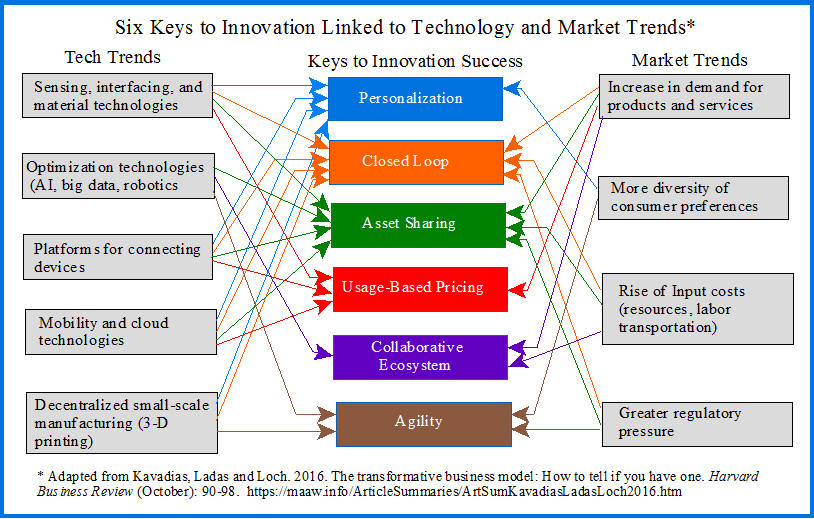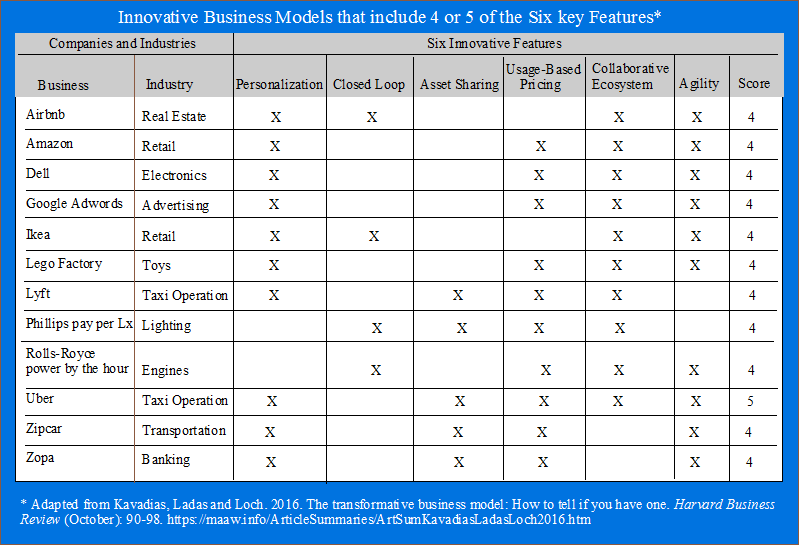
Summary by James R. Martin, Ph.D., CMA
Professor Emeritus, University of South Florida
Business Models Bibliography |
Strategy Related Main Page
An industry's transformation is usually associated with the adoption of a new technology, but new technologies have never transformed an industry on their own. What is needed is a business model that links the new technology to an emerging market need. The purpose of this paper is to explain how this is done based on an in-depth analysis of 40 companies that launched new business models in a variety of industries.
How Business Models Work
A business model describes how a company creates value by defining the customer value proposition and pricing mechanism. It also describes how the company is organized including its partners and supply chain. Industries tend to have a dominant business model that emerges over time. Although most attempts to introduce a new model fail, some succeed by leveraging a new technology. For example, Airbnb developed a new model that challenged the traditional economics of the hotel industry. Airbnb does not own or manage property. Instead it allows users to rent property through an online platform matching renters with home owners willing to share a room or house. It simply takes a percentage of the rent. Airbnb's value propositional offers a more personal service at a lower cost. Their new business model connects what online technology enables with what the marketplace wants.
Six Keys to Success
The authors identified six keys to success based on an analysis of 40 new business models that appeared to have the potential to transform their industries. Company models with a higher number of these six features were correlated with a higher chance of transformation. The six features are as follows:
1. A more personalized product or service. Providing products or services that are better tailored to customers' individual and immediate needs than the dominant model.
2. A closed-loop process. Recycling used products to reduce overall resource costs.
3. Asset sharing. Sharing costly assets reduces cost and reduces entry barriers.
4. Usage-based pricing. Customers are charged when they use the product rather than having to purchase the product.
5. A more collaborative ecosystem. Collaborating with supply chain partners allocates business risks and facilitates cost savings.
6. An agile and adaptive organization. Real time decisions are made based on changes in market needs.
Long Term Trends in Technology and Demand
Each of the six features is linked to a recognized technology trend and a recognized market trend. Each feature represents a potential solution for linking what the market needs to the new technological capabilities.
Technology trends include:
The development of sensors that provide for cheaper and broader data capture.
Big data, artificial intelligence, and machine learning that enables companies to convert large amounts of data into rules and decisions.
Connected devices and cloud technology that permit widespread data manipulation and analysis.
Developments in manufacturing such as nanotechnology and 3-D printing that create more possibilities for small-scale production.
Market trends include:
The progress of developing countries has lead to a worldwide increase in demand for products and services.
More diversity in customer preferences.
Higher input costs for resources.
More regulation.
The following illustration shows the connections between the six key business model features and the tech and market trends.

From Innovation to Transformation
The theory is that the more key features a new business model has, the greater the potential for transforming the industry. To test the theory, the authors analyzed how many of the features each of the 40 new models included, and then compared the results to each model's actual performance, e.g., gain in market share and the extent the model was copied by other companies. Note that each key feature has a different meaning in each industry. For example, personalization might mean tailored loan terms in the financial services industry, but data-enabled targeted medicine in the health care industry.
The results of this research indicated that transformative business models have three or more of the six features. The authors provide a table on page 97 showing all 40 business models and the key features associated with each model. The illustration below provides a subset of that table showing the 12 most innovative models found in the study.

Uber's Taxi Operation
Uber's innovative taxi operation is associated with five of the six key features. These include asset sharing (the drivers use their own cars), collaborative ecosystem (the drivers assume the risk of obtaining riders, but the platform minimizes the risk using big data), usage-based pricing (the fare varies for each trip), agility (an internal decision-making system responds in real time), and personalization (customers rate drivers and can see the closest drivers and their ratings on their mobile phones).
Healx: A Case Study in the Field of Personalized Medicine
The Healx business model focuses on the health care of patients with rare diseases. Healx matches treatments to rare-disease patients with a platform that uses big data technology and analytics across multiple databases owned by different organizations. Their initial model included three of the six keys to transformative innovation. These included asset sharing (e.g., use of clinical-trail databases that measured the effectiveness of various drugs on common and rare diseases), personalization (identifying drugs with high potential for treating the rare diseases covered), and collaborative ecosystem (matching big pharma companies that have the trial data with health care providers that have the effectiveness, incompatibility reactions, and personal genome descriptions). Realizing their technology could predict the failures that result from specificities in individual genomes, Healx developed a machine learning algorithm that could match drugs to disease symptoms and predict exactly which drug will achieve a specific level of effectiveness for a particular patient. This added agility to the model by making it possible for the treating clinician to make better treatment decisions directly with the patient rather than relying on rules of thumb related to which drugs to use.
Transforming an Industry
There are no guarantees, but business models that link market needs to emerging technology have a better chance of transforming an industry. The more links a model has the more likely the model will transform an industry.
_____________________________________________
Related summaries:
Bonnet, D. and G. Westerman. 2021. The new elements of digital transformation: The authors revisit their landmark research and address how the competitive advantages offered by digital technology have evolved. MIT Sloan Management Review (Winter): 82-89. (Summary).
De Geus, A. 1999. The living company. Harvard Business Review (March-April): 51-59. (Summary).
Johnson, M. W., C. M. Christensen and H. Kagermann. 2008. Reinventing your business model. Harvard Business Review (December): 50-59. (Summary).
Magretta, J. 1998. The power of virtual integration: An interview with Dell Computer's Michael Dell. Harvard Business Review (March-April): 72-85. (Summary).
Magretta, J. 2002. Why business models matter. Harvard Business Review (May): 86-92. Explains the difference between a business model and a competitive strategy. (Summary).
Mintzberg, H. and L. Van der Heyden. 1999. Organigraphs: Drawing how companies really work. Harvard Business Review (September-October): 87-94. (Summary).
Porter, M. E. 1980. Competitive Strategy: Techniques for Analyzing Industries and Competitors. The Free Press. (Summary).
Porter, M. E. 1987. From competitive advantage to corporate strategy. Harvard Business Review (May-June): 43-59. (Summary).
Porter, M. E. 1996. What is a strategy? Harvard Business Review (November-December): 61-78. (Summary).
Van Alstyne, M. W., Parker, G. G. and S. P. Choudary. 2016. Pipelines, platforms, and the new rules of strategy: Scale now trumps differentiation. Harvard Business Review (April): 54-62. (Summary).
Zhu, F. and M. Iansiti. 2019. Why some platforms thrive and others don't: What Alibaba, Tencent, and Uber teach us about networks that flourish. The five characteristics that make the difference. Harvard Business Review (January/February): 118-125. (Summary).